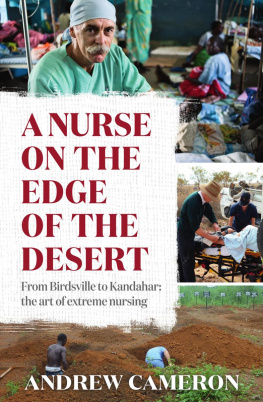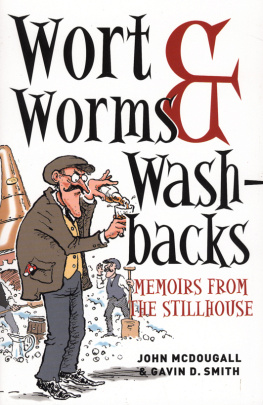
Scotlands smallest distillery
ANDREW CAMERON

Copyright 2015 Andrew Cameron
The moral right of the author has been asserted.
Apart from any fair dealing for the purposes of research or private study, or criticism or review, as permitted under the Copyright, Designs and Patents Act 1988, this publication may only be reproduced, stored or transmitted, in any form or by any means, with the prior permission in writing of the publishers, or in the case of reprographic reproduction in accordance with the terms of licences issued by the Copyright Licensing Agency. Enquiries concerning reproduction outside those terms should be sent to the publishers.
Matador
9 Priory Business Park,
Wistow Road, Kibworth Beauchamp,
Leicestershire. LE8 0RX
Tel: (+44) 116 279 2299
Fax: (+44) 116 279 2277
Email:
Web: www.troubador.co.uk/matador
eISBN 978 1784628 482
British Library Cataloguing in Publication Data.
A catalogue record for this book is available from the British Library.
Matador is an imprint of Troubador Publishing Ltd
Contents
Authors note
By the time I had completed the first edition of this short book Edradour was already evolving under the stewardship of its new owner, Andrew Symington.
Seven years later and much has changed. There is now a new bottling plant on-site, a conference centre, new warehouses and staff accommodation. The visitor centre and tasting rooms have swapped places and both have been refurbished and improved.
All these changes have been made with great care and without impacting all that is magical about this small distillery.
The whisky itself has also improved through an ever increasing range of expressions including Ballechin, a peaty whisky that was just being produced when I wrote the first edition of this book.
With so much happening at the distillery it was time to provide an update but Ive also received letters from all over the world from relatives of people who were once associated with the distillery and their memories of Edradour shine new light on the past.
This second edition of the history of Edradour includes new research and the memories of those who were kind enough to get in touch.
Andrew Cameron
September 2014
London

Key dates in the history of Edradour Distillery
1825 | Alexander Forbes is granted a license to distill in Edradour |
1837 | The Edradour Distillery starts production |
1837 | The first formal partnership is formed under John McGlashan |
1853 | James Reid takes over the distillery |
1885 | John McIntosh takes over the distillery expanding and modifying the distillery |
1907 | Peter McIntosh takes over from his uncle expanding and updating the equipment |
1933 | William Whiteley buys the freehold from the Duke of Atholl and takes over. Edradour becomes a core element of House of Lords, Kings Ransom and other Whiteley whisky brands |
1938 | The business is sold to Irving Haim, a known associate of the Mafia |
1947 | Electricity is installed at the distillery |
1978 | The business is bought by Burton Gintell who grows the international market |
1982 | Pernod Ricard acquire Edradour Distillery and all associated brands |
1985 | A visitor centre is opened and Edradour becomes a tourist attraction |
1986 | The Edradour 10 year old single malt is released and marketed for the first time |
2002 | Andrew Symington purchases the distillery from Pernod |
2005 | Ballechin, a peaty whisky, is produced at Edradour |
2007 | The bottling plant is built on-site |
2009 | A new large warehouse is built |
2014 | The Ballechin 10 year old is released |
Introduction
At the end of a long day there is nothing quite as relaxing as sinking into my favourite leather armchair, putting my feet up on the rest and gently easing the lid from a bottle of single malt whisky. The gentle pop gives way to an inviting aroma that cheers the soul like an old and dear friend.
Carefully pouring a good measure into a short but wide tumbler I inspect the colour as it settles in the glass. Whether its light straw or deep red in colour hints at how long the spirit has spent locked away in a darkened warehouse slowly maturing for my pleasure.
To taste single malt whisky is to experience a variety of flavours that refresh, warm, and excite the palette. You can sniff, swirl and hold up to the light if you want but to enjoy whisky you simply need to find the one, or ones, that help you unwind, relax and enjoy the occasion whatever it happens to be.
The Scots believe that it was only when distillation came to Scotland that it was perfected. Some even believe that Scotland was created for distillation with its climate and geology providing the perfect conditions for making and maturing whisky. Others believe that it was God himself who gave the Scots whisky and only when realising that he had been too generous in the number of beautiful things he had bestowed upon the country, gave them the English as neighbours to balance the books.
The oldest record in Scotland for Aquavite, or whisky as we now know it today, dates back to an entry in the Exchequer Rolls in 1494 stating that Friar John Corr, of Lindores Abbey, paid duty on 8 bolls of malt to make Aquavite for King James.
Of course the good folk in the Highlands had been making whisky long before that and process of distillation itself has been around for thousands of years, probably starting in the Middle East.
Wherever and however the practice of distilling reached the shores of the Highlands, Scotland and whisky are inextricably linked and there is no better way to understand the whisky making process and the turbulent story of the distillers than at Scotlands smallest established distillery, The Edradour.
I first visited Edradour in 2002 just after Andrew Symington, the present owner, had taken over. I knew nothing of the distillery, or its whisky, prior to my visit but the irresistible charm of the place is enough to make anyone smile. Also, as I found out, the whisky is pretty good too.
It was on my second visit in 2005 that I was inspired to find out more about this lovely distillery. Looking through the glass cabinets in the old malt barn, gazing at the bottles of Kings Ransom and House of Lords, listening to our guide talking about the previous owners and rumours that the distillery had connections with the Mafia but the details lost in time and those associated long since passed away. All of this intrigued me and I wanted to find out more.
When I considered that distilling had taken place here for nearly 200 years I knew that this little distillery must have a great story to tell, if only the details could be uncovered.

















